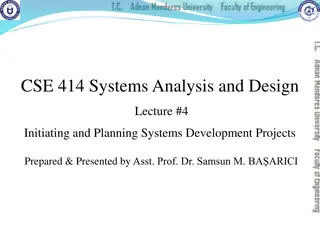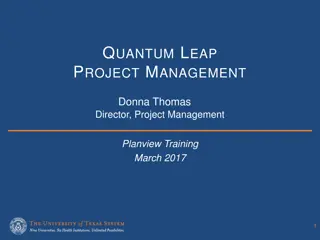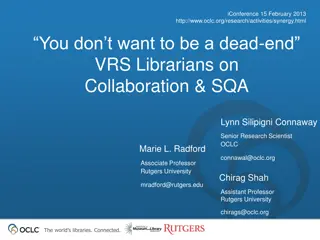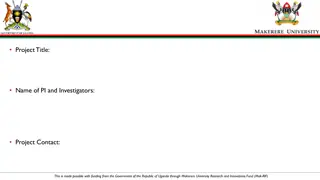Collaboration Project between JINR, University of Sofia, and INRNE
Collaboration project between JINR, University of Sofia, and INRNE to create a distributed information and computing infrastructure using cloud and grid technologies. The project aims to establish a common environment for scientific research, training, and education by integrating resources from different institutions. This initiative will help in solving fundamental scientific and application problems that require advanced computational methods and distributed data storage systems, fostering cooperation and knowledge exchange among the participating organizations.
Download Presentation

Please find below an Image/Link to download the presentation.
The content on the website is provided AS IS for your information and personal use only. It may not be sold, licensed, or shared on other websites without obtaining consent from the author. Download presentation by click this link. If you encounter any issues during the download, it is possible that the publisher has removed the file from their server.
E N D
Presentation Transcript
Clouds of JINR, University of Sofia and INRNE Join Together Vladimir Korenkov (JINR), Nikolay Kutovskiy(JINR), Nikita Balashov (JINR), Vladimir Dimitrov (University of Sofia, Bulgaria), Radoslava Goranova (University of Sofia, Bulgaria), Kuzma Kouzmov (University of Sofia, Bulgaria), Svetozar Hristov(INRNE, Bulgaria)
Creation of distributed information and computing infrastructure using cloud and grid technologies based on resources of the Laboratory of Information Technologies of the Joint Institute for Nuclear Research, Institute for Nuclear Research and Nuclear Energy of the Bulgarian Academy of Science and Sofia University St. KlimentOhridski is 3 years project with priority funding in the period 2017-2019. The Project
Project aim is to be created common distributed information and computational environment using Cloud and Grid technologies on the capabilities available at LIT JINR, INRNE BAS and FMI SU. This environment will be used for further scientific research, training and education in common concerns of the participants and third parties. Targets The establishment of such an environment is important to join participant efforts and resources in solving fundamental scientific and application problems that successfully can be solved only with new methods and approaches to distributed and parallel computations and with systems for distributed storage of large amounts of data.
The project target research is to find out how to integrate LIT JINR, INRNE and FMI SU resources in an optimal way. The resulted infrastructure must help to fasten the scientific research at JINR and to establish a base for training and education in Bulgaria of computer professionals on advanced technologies for big scientific data storage, processing and analyses. The experience and skills acquired in this environment could be used for solving problems in many different areas. Project Problems
There are many scientific research centers in Bulgaria, among them are INRNE and University of Sofia, which have from many years traditional, high level cooperation with JINR in the fundamental scientific research and investigations. New emerging technologies from the last years on networking, computing and data management impose JINR resources to be in common share with that one of member countries and in particular with Bulgarian scientific research centers, targeting particular scientific and application problems. There are many problems that could not be solved without the new modern approaches in the area of information and computational environments for storage, processing and analyses of big scientific data. The establishment of such an environment will intensify the cooperation between JINR and Bulgarian institutes, will reduce the time frame for obtaining new scientific results, and will serve as a powerful impetus on the development and usage of these new emerging technologies in Bulgaria. Project Foundations
Today, many scientific studies that could not be conducted without systems for collecting, storage, processing analyzing information. Moreover, often the data volumes of data are collected and must be analyzed exceed the capabilities of one, even the largest, scientific organization. In that context, the task for resources integration of research centers in one common infrastructure is urgent one. In the biggest worldwide projects, this task is solved using Cloud and Grid technologies. Such a global infrastructure is Worldwide LHC Computing Grid (WLCG) established for Large Hadron Collider (LHC) computing. This infrastructure includes hundreds of data processing and computing facilities worldwide. Starting from 2003, JINR, INRNE and SU participate in WLCG. Current Research The project goals are in synchrony to the world trends in the development of new information technologies and computing. The establishment of common Cloud and Grid infrastructure JINR -Bulgaria, on one hand will meet the scientific researchers need for more resources, will improve resources utilization, and from strategic point of view will strength Bulgaria s position among the countries that use and implement advanced information technologies.
1. The establishment of distributed information and computing infrastructure segments in INRNE and SU that is shared with corresponding infrastructure at JINR. 2. The researchers from JINR, INRNE and SU will use together all shared resources to solve concrete problems from JINR scientific program in collaboration or separately with participating Bulgarian scientific organizations. Expected Results 3. A software stack will be developed for information and computing resources integration and corresponding knowledge and training for its application will be delivered in Bulgaria. 4. Training events will be organized and conducted for Bulgarian professionals on the environment resource usage. 5. Virtual computers will be instantiated for INRNE, SU and other BAS institutes, for cooperative or separate research with JINR.
The Networking and Computing Infrastructure of JINR is a distributed software and hardware complex based on specialized software and multifunctional equipment. The core of this infrastructure is the Multifunctional Information -Computational Complex of JINR. This infrastructure uses JINR local area network that connects all JINR resources into single information and computing environment accessible to all JINR users. The complex implements Grid technologies. It supports the data exchange among the scientific laboratories and the administration. The Networking and Computing Infrastructure of JINR The complex has telecommunication channels that provide remote access to Russian and foreign scientific networks and support the remote access to JINR resources. The purpose of this infrastructure requires to be supported high secure, reliability and scalability levels in combination with ease system maintenance.
Currently, JINR has an external telecommunication channel for data transmission with the speed of 100 Gbits / sec. The JINR local area network connects 8148 computers and nodes. Telecommunic ation Channels of JINR The central communication node has been upgraded to be the fault tolerant core of this LAN communication structure. It supports high network security and reliability levels, has good data transmission parameters and tools for monitoring of, management of, and remote access to the nodes. The backbone networks operates at a data transfer rate of 10 Gbits / sec.
The multifunctional information and computing complex of JINR consists of: 1. Tier 1 level JINR center for CMS experiment at LHC with configuration and parameters: 3600 computing nodes; 4.5 PB disk storage; 5.4 PB tape library. The Computing Infrastructure of JINR 2. Tier 2 level JINR center for experiments E391A (KEK), COMPASS, D0, DIRAC, HARP, CMS, ALICE, ATLAS, H1, NEMO, OPERA, HERMES, CBM, PANDA etc., for physical processes modeling and experimental data analyses, with configuration and parameters: 3470 computing nodes; 2 PB disk storage. The JINR LIT Cloud infrastructure consists of 400 cores, RAM 980 GB, distributed file system of 16 TB, the local disk space on the servers with virtual machines is 42 TB.
Currently, INRNE does not have production Grid farm. The planned Cloud infrastructure will consists of available 6-10 servers with parameters: Intel Xeon 2.80 GHz, RAM 2 GB, and HDD 80 GB. Additional 10-12 TB disk storage must be added to theses servers. INRNE Resources For reliable and stable operations of this local Cloud must be acquired suitable air condition and UPS. New servers and components will be acquired for this Cloud infrastructure after its initial establishment.
University of Sofia Resources The Grid farm at University of Sofia is managed and supported by Faculty of Mathematics and Informatics and Faculty of Physics. It is based at Faculty of Physics. This is production farm that is part of the European Grid infrastructure. Its configuration is given in the figure below.
University of Sofia Grid farm
Computing Nodes: CPUs: 80 Cores: 160 Threads: 320 RAM: 655360 (640 GB) Lan: 1 GigB University of Sofia Grid farm Total Resources Storage: 8 x RAID arrays: Total: 72.8 TB Configured Arrays: RAID6 Distributed File system: dCache
1. Investigation of available solutions for building common distributed information and computing environment based on the resources of LIT JINR, INRNE, and SU. 2. Acquisition of necessary equipment and establishment of test sites at INRNE and SU, based on the selected solution. 3. Conduct of training for Bulgarian specialists. 4. Integration of JINR LIT and Bulgarian sites into common distributed information and computing environment. Working Plan 5. Testing the distributed information and computing environment. 6. Exploitation of the distributed information and computing environment for concrete scientific and application problems at JINR and Bulgarian centers. 7. Acquisition and installation of new resources for increasing the power this distributed information and computing environment for solving scientific and application problems.
Currently, the project is in its initial phase. Selected solution for integration is based on the OpenNebula. Activity 3 has been conduct this year. Conclusion On the currently available equipment at University of Sofia has been partly installed a test site. Till the end of the year this site will be moved in the newly acquired equipment for final establishment of site infrastructure.





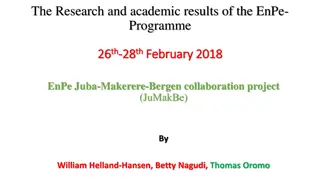
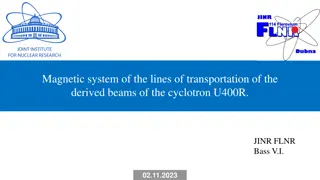

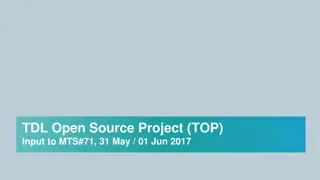






![Project Initiation Document for [Insert.Project.name] [Insert.Project.number]](/thumb/226757/project-initiation-document-for-insert-project-name-insert-project-number.jpg)




